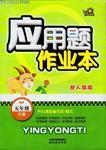题目内容
_________ very confused,the girl consulted her teacher to find out the answer.
- A.Being felt
- B.Felt
- C.Feeling
- D.To feel

 应用题作业本系列答案
应用题作业本系列答案Some scientists say that animals in the oceans are increasingly threatened by noise pollution caused by human beings.
The noise that affects sea creatures comes from a number of human activities. It is caused mainly by industrial underwater explosions, ocean drilling, and ship engines. Such noises are added to natural sounds. These sounds include the breaking of ice fields, underwater earthquakes, and sounds made by animals themselves.
Decibels (分贝) measured in water are different from those measured on land. A noise of one hundred and twenty decibels on land causes pain to human ears. In water, a decibel level of one hundred and ninety-five would have the same effect.
Some scientists have proposed setting a noise limit of one hundred and twenty decibels in oceans. They have observed that noises at that level can frighten and confuse whales.
A team of American and Canadian scientists discovered that louder noises can seriously injure some animals. The research team found that powerful underwater explosions were causing whales in the area to lose their hearing. This seriously affected the whales' ability to exchange information and find their way. Some of the whales even died. The explosions had caused their ears to bleed and become infected.
Many researchers whose work depends on ocean sounds object to a limit of one hundred and twenty decibels. They say such a limit would mean an end to important industrial and scientific research.
Scientists do not know how much and what kinds of noises are harmful to ocean animals. However, many scientists suspect that noise is a greater danger than they believed. They want to prevent noises from harming creatures in the ocean.
【小题1】 According to the passage, which of the following is increasingly dangerous to sea creatures?
| A.The man-made noises. | B.The noises made by themselves. |
| C.The sound of earthquakes. | D.The sound of the ice-breaking. |
| A.Different places with different types of noises. |
| B.The very human ears sensitive to all types of noises. |
| C.The same noise measured differently on land and in the ocean. |
| D.The ocean animals' reaction to noises. |
| A.They are deaf to noises. |
| B.Noises at a certain level may hurt them. |
| C.They are easily confused by noises. |
| D.Noises will limit their ability to reproduce. |
| A.They will try their best to decrease noise. |
| B.They will work hard to cut down noise pollution. |
| C.They will study the effect of different noises. |
| D.They will protect animals from harmful noises. |